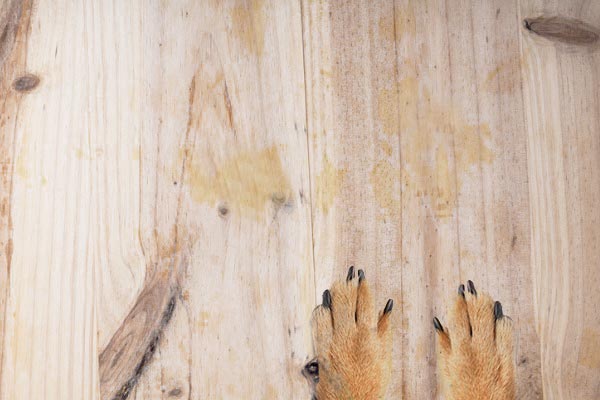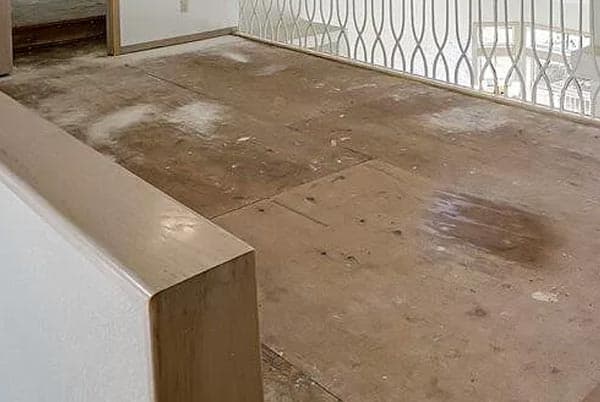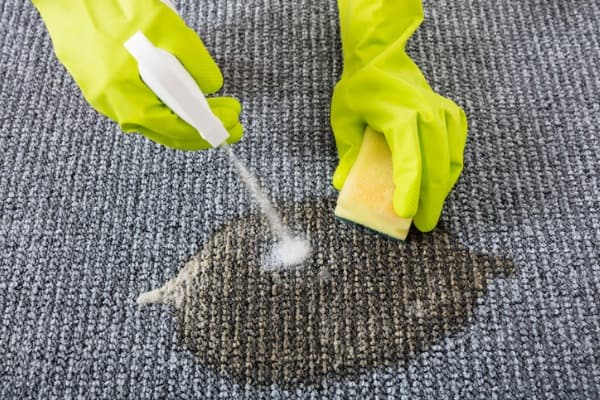Do you have carpet, wood flooring, or laminate? What about bamboo flooring? Do you also have a pet?

Spoilers ahead! Any urine accidents on the aforementioned floors can result in a nasty problem- urine soaked into your subflooring.
Pet urine stains are tricky to deal with but bearable if you can tackle them with the right products.
This is fine if you catch the problem in time, but what if the stain has had a chance to soak into the delves of your floor?
Urine stains and smell is a common issue many pet parents are faced with. Cleaning it is a must – and you wonder if urine is harmful to you and your family.
Or perhaps your new housing had less than responsible pet owners as previous tenants.
In that case, the stains are no fault of your fur baby.
In any scenario, pet stains can cause unsightly spots and unpleasant smells in your home.
So are you wondering how to get cat or dog urine out of wood under the carpet? Or wood under any other type of flooring? Perhaps you have urine that soaked through hardwood.
It’s a little more complicated than treating a simple stain, but you won’t have to replace the entire subfloor because of just a few spots.
The Deeper Issue

Removing a fresh urine stain from carpet or even wood is pretty straightforward – some basic household supplies and enzymatic cleaner are usually enough to do the trick.
But do stains ever soak down past the carpet, wood, or laminate? The icky truth is yes, they can.
The larger the pet, the larger the puddle – if you have a big-breed dog that won’t pee outside or a notably bulky cat, they might relieve themselves to the point that the urine reaches your subfloor.
Some pets are repeat offenders. Animals are often attracted back to the same spots where they first urinated – often, they urinate several times before being caught.
In these instances, urine has the opportunity to seep past the carpet and carpet padding.
Similarly, it can sneak past your wood, tile, and laminate and set up residence on your subfloor.
Does this mean you need to pull up your primary flooring?
That depends.
Old stains can often be treated with dog urine remover, such as an enzyme cleaner; this product can penetrate beyond your carpet, tile, and wood flooring.
Deep-set stains and spots that have been defiled by your pet repeatedly might require you to remove some flooring and attack the spot beneath.
What if you don’t do that?
If the stain has reached your subfloor, treatments with DIY solutions or enzyme cleaners will only treat what they can reach.
See also:
- Urinary Care Dog Food: Top 5 Diet Options for Optimal Urinary Health
- Dark Urine in Dogs: Why It’s Not Good and 5 Things to Do Now
- My Dog Smells Like Urine! Let’s Solve This!
You would have to very thoroughly saturate a large area to address the issue in the subfloor.
Otherwise, the smells and potential spots will resurface over time.
High temperatures, humidity, and steam cleaning can all cause a deep-set stain to show itself even after the surface covering has been treated.
So if you’re battling a stain that seems to keep popping up every so often, it might be time to remove some flooring and take the fight straight to the subfloor.
Most stains that have been taken care of promptly won’t result in this difficult issue, so don’t go tearing up the carpet over one urine accident.
But when that cleaning routine doesn’t seem to eliminate the spot?
It might be time to expose the subfloor and give it a good enzyme cleaner bath.
Wick-or-Treat?
Absorbing – or wicking – liquid from the flooring is the best weapon against set-in stains.
But what if you didn’t have the opportunity to take care of a pet urine accident as soon as it happened?
It’s time to treat it.
The following routine will work on wood floors, urine-stained tile, laminate, and carpeting.
But for this article, I’ll talk you through the steps of treating your subfloor when treating on the surface just isn’t cutting it.
Follow These 3 Steps for How to Remove Urine from a Subfloor:
1. Remove your primary flooring
You don’t need to remove the entire floor to treat one spot. If you’re treating the subfloor under tile or wood, your job will be a little easier.
Carpet presents some unique challenges, but it’s not impossible.
If subflooring under tile or wood is in need of some TLC, you can remove the primary flooring yourself.
The only kicker here?
It is difficult to remove tile without breaking it. A tile remover shank can be helpful in the process.
Hopefully, you have a few spare tiles lying around the house. If not, it might be time to make a trip to the home improvement store.
It’s a little bit easier to do the same with wood flooring without ruining it.
As you’ve probably noticed, some required tools might not be in everyone’s household tool stockpile.
Hiring a professional to remove the flooring over the affected area is always possible.
If the urine stain is severe enough that you feel it necessary to treat the subfloor, then calling in the pros isn’t as extreme as it sounds.
As for the carpet?
Count your lucky stars if the urine stain is in a corner or on the edge of a floor – removing the carpet is as simple as pulling it back and going after the problem.
A stain in the middle of a carpeted room requires more legwork.
2. Treat the subfloor
Once you have exposed the stain on the subfloor, it’s time to treat it.
You could try a DIY solution at this stage, such as a vinegar and detergent solution.
However, if the stain is so troublesome that you have to pull up some flooring to treat it, I would suggest going straight for the “big guns.”
Numerous enzyme cleaners are out there, and each one offers its own benefits.
We recommend sticking to ones that are clearly marked as safe and natural.
Our favorite on a subfloor? BUBBAS Super Strength Commercial Enzyme cleaner.
In the case of enzyme cleaners, all-natural doesn’t detract from its effectiveness.
In fact, the natural element of enzyme cleaners – the good bacteria in them, that is – makes them a better choice than other harsh cleaners.
Enzyme cleaners attack and eliminate the particles that cause smells and spots.
It’s the best first option for urine stains and also works as a last-ditch effort when other methods have failed you.
Most enzyme cleaner comes in spray bottles.
I highly recommend putting some in a spray bottle if you bought a large bottle.
Applying enzyme cleaner via spray ensures an even, thorough coating over the area.
Enzyme cleaners work best when left for several hours or even overnight.
After spraying the area, let it sit as long as the brand recommends.
You’ll need to keep your subfloor clear while it works, so don’t replace that floor or carpet quite yet.
It can help if you air out the room by keeping windows open or aiming a fan at the spot.
3. Put your floor back
Whether you hired professionals or removed the primary flooring yourself, you’ll only want to put things back in place once the spot has completely dried.
Odds are you already tried treating the carpet before you tore everything up.
You might be tempted to do it again once you’ve dealt with the stain on the subfloor.
My best suggestion is to give it a few days before you do anything else to the area.
It might surprise you that the pesky stain that kept showing up has vanished for good.
Preventing Future Home Improvement Ventures

If you had to tear up the flooring to treat your subfloor, you undoubtedly want to avoid another weekend reminiscent of an HGTV show.
You can take steps to protect your subfloor further.
Of course, not letting your dog hold its urine for too long is one behavior you can adjust.
But when it comes to protecting subfloors, you can always add a protective liner if you’ve gone to the point of lifting up your flooring.
A vapor barrier just like this one can easily roll out as an underlayment to cover your subflooring and prevent liquid and other unwanted moisture from penetrating through to your subfloor material.
It’s definitely worth the trouble if you can do it.
Otherwise, the good news is that Bubba’s enzyme cleaner works wonders in keeping your pet from being tempted by an old urine stain.
Frequently Asked Questions
After reading these steps you may have a few additional questions

What about the rest of the floor?
As you may know, it is not practical to rip up multiple patches of carpet on a regular basis.
If you’ve moved into a home that had less than stellar former inhabitants, you might want to start from scratch.
At some point, it becomes easier to remove the carpet and replace it.
How do you treat a plywood subfloor for urine before the new carpet is installed?
If urine stains have set into the plywood subfloor, you can treat it in the same way you would treat any subfloor.
Note that some wood reacts and swells on contact with any liquid – an issue that might already exist as a result of urine.
Enzyme cleaners often recommend you spot-test small areas of wood before treating a larger area.
This will allow you to observe how the plywood subfloor will react.
You can make sure enzyme cleaner is a viable option before resorting to replacing the subfloor.
Is a concrete pad or foundation the same as a subfloor?
Generally speaking, the answer is No. A subfloor is most often a wood surface laid down over joists as the bottom layer for a finished floor that lays on top of it.
Of course, any bottom layer can be penetrated by a pet accident. And, getting dog and cat urine smell out of concrete is no easy task unless you know what you’re doing.
Fortunately, this is just another type of foundation, and the treatment approach is very similar. You’ve got to get the stained area soaked with an organic cleaner to rid the stain and urine odor under your finished layer.
Will an enzyme cleaner make it safe to put down brand new carpeting?

It is indeed the best measure you can take without replacing the subfloor. No one wants new carpeting immediately ruined by old stains resurfacing.
I recommend following the same steps outlined above, in all affected areas. I also suggest letting them dry and watching the spots for several days before you install the new carpeting.
Why so long?
You’ll get a better idea of if the enzyme cleaner did its job if you wait a few days.
You can even put old towels or doormats over the spot once it’s dry, as a test.
If the stain manages to rear its ugly head through either of these, it might be necessary to replace some or all of the subfloor.
You can also seal your subfloor before putting down any new flooring. Subfloor sealing will help repel liquid – not just the urine variety.
Sealant goes a long way to prevent future stains from setting in.
Subfloors and Urine Don’t Mix
If pet urine has reached your subfloor, you’ll be caught in a tough cycle where stains will resurface in your flooring, and you will have to clean them.
Although some situations require expert help, this is an issue you can generally take care of on your own.
So just how to get dog urine out of wood under carpet? Enzyme cleaner is your best friend – after your pet, of course.
Even if they’re the cause of the stain in the first place, we still love them. After all, accidents happen to the best of us.

